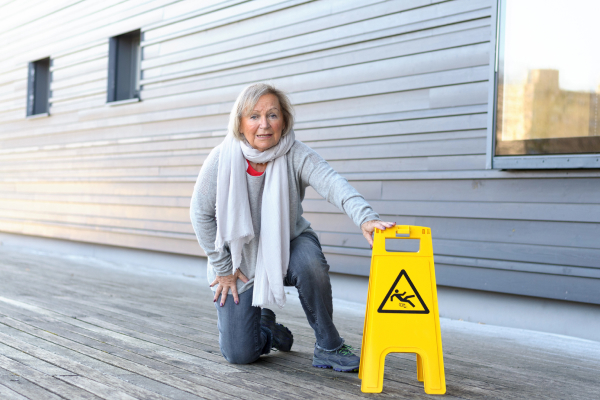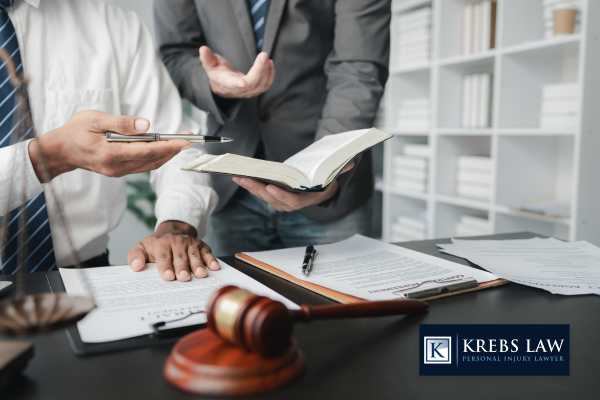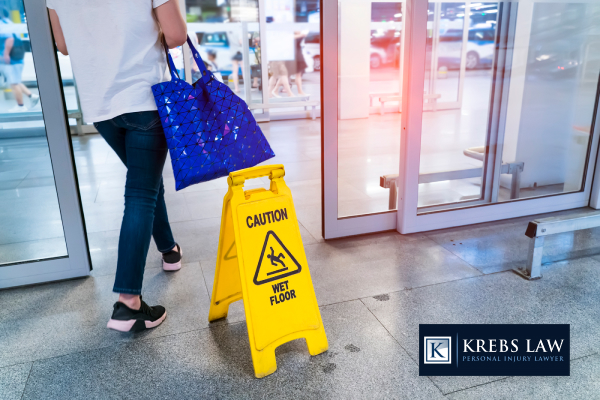This page was written, edited, reviewed & approved by JR Krebs following our comprehensive editorial guidelines. JR Krebs, the Founding Partner, has years of legal experience as a bankruptcy attorney. Our last modified date shows when this page was last reviewed.

A slip-and-fall case happens when someone is injured after slipping or tripping on someone else's property. If you’ve fallen because of dangerous conditions, like wet floors or uneven surfaces, you may have a valid claim.
Krebs Law Personal Injury Lawyers help you understand what you need to prove in a slip-and-fall case. You must show that the property owner was negligent, meaning they didn’t fix a dangerous condition. It is essential to gather the right evidence, get medical treatment, and work with an experienced personal injury lawyer to build your case.
A slip-and-fall case involves an accident that happens when someone slips, trips, or falls due to hazardous conditions on a property. These accidents can occur in stores, restaurants, or even private homes. Often, the fall happens because of wet floors, poor lighting, or uneven walking surfaces. In such cases, the injured person can file a slip-and-fall claim to hold the property owner responsible.
If you’ve been injured in a fall accident, it’s important to act quickly. The property owner may try to deny liability, and evidence could disappear over time. A slip-and-fall lawsuit can help you seek compensation for medical bills, lost wages, and pain.

To win a slip-and-fall case, four key elements must be proven. They include:
Every property owner has a duty to keep their property safe for visitors. This means they must remove hazards that could lead to accidents. For example, a store owner must keep the floors dry to prevent slips. If the owner fails to do this, they may be found negligent.
To prove a duty of care, you must show that the property owner was responsible for the area where the fall occurred. This may involve showing that the property owner had control over the premises or hired employees to maintain it.
A breach of duty happens when the property owner fails to fix or warn people about a hazardous condition. For example, if the owner knew about a wet floor but didn’t put up a warning sign, they may have breached their duty. In a fall case, showing that the property owner ignored or failed to address the hazard is crucial.
Gather evidence, such as witness statements or photos, to prove the property owner’s negligence. Without this proof, your case may be weak.
Causation connects the breach of duty to the injuries suffered. In other words, the fall must be directly related to the property owner’s failure to maintain a safe environment. You need to show that the dangerous condition caused your injury and that you would not have fallen if the owner had fixed the issue.
For example, if you slipped on a wet floor because the owner didn’t clean it up, the wet floor is the direct cause of your fall.
Damages refer to the injuries and losses you suffered because of the fall. This could include medical bills, lost wages, pain, and suffering. To win a slip-and-fall case, you need to prove that the fall caused you real harm.
If you’ve been hurt in a fall accident, you can seek compensation for medical expenses, lost wages, and more. The more evidence you have, the better your chances of getting fair compensation.
Gathering evidence is key to winning a slip-and-fall case or a personal injury case in general. Without solid proof, it’s hard to show the property owner’s negligence. Some common types of evidence you should collect are:
Photographs and videos can be very helpful in proving the condition of the property. They can show exactly where the fall occurred and the hazard that caused it. If possible, take pictures of the area before leaving the scene.
Security camera footage can also be valuable. If the property has cameras, it may capture the fall accident. This footage can serve as a strong piece of evidence in your slip-and-fall lawsuit.
Witnesses can help confirm what happened during the fall accident. If someone saw you slip or trip, their statement could provide key details, so get their contact information as soon as possible.
Witnesses may also explain the hazardous condition, like a wet floor or poorly lit area, which led to the fall. These statements add credibility to your claim.
Incident reports can provide official documentation of the fall. Many businesses have a system for reporting accidents. These reports include important details, like the time, location, and cause of the fall.
Make sure to file a report if you can. It will show that you took the fall seriously and notified the property owner right away.
After a fall, you must get medical treatment. Your medical records will show the injuries you suffered and the treatments you received. This documentation can help you prove the damages in your slip-and-fall claim.
Medical records also serve as evidence that the fall caused your injuries. They can be crucial for securing compensation in a fall lawsuit.
Surveillance footage can be a powerful tool in your case. If the property has security cameras, the footage may show the hazardous condition and your fall. This visual evidence can help show the property owner’s liability.
If you’re involved in a slip-and-fall accident, it’s worth asking for surveillance footage. It could make or break your case.

To win a slip-and-fall case, you must prove that the property owner was negligent. This means showing that they failed to keep their property safe. Proving negligence can be challenging, but with the right evidence, it’s possible to hold the property owner liable for your injuries.
Now, let’s look at the factors that help prove the property owner’s negligence.
To prove the property owner’s negligence, you must show that they knew about the dangerous condition. For example, if the property owner was aware of a wet floor but didn’t take action to clean it or warn visitors, they may be responsible for the accident.
You can show this through witness statements, incident reports, or even past complaints about the same hazard. Proving awareness is an important step in your slip-and-fall lawsuit.
Even if the property owner knew about the hazard, they must take reasonable steps to fix it or warn people. If the owner failed to address the issue, this could be considered negligence.
For example, if the property owner knew about a broken sidewalk but didn’t repair it for months, they may be held responsible for a fall accident caused by the broken sidewalk. Proving that the owner did not act on the hazard is essential to your case.
In some slip-and-fall cases, the property owner might argue that the person who fell was partly to blame for the accident. This is called comparative negligence. It means that both the injured person and the property owner may share some responsibility.
In a fall case, if you are found partially at fault, your compensation may be reduced. However, even if you are partly responsible, you can still seek compensation for the damages you suffered.
Hiring an experienced personal injury lawyer can make a big difference in the outcome of your case. A skilled attorney understands the legal process and can help gather evidence, speak to witnesses, and file the necessary paperwork.
Krebs Law Personal Injury Lawyers have years of experience handling slip-and-fall cases. We will guide you through every step, from proving negligence to fighting for fair compensation. With our help, you can increase your chances of a successful slip-and-fall claim.
What should I do immediately after a slip-and-fall accident?
If a slip-and-fall accident occurs, seek medical attention right away. Report the accident to the property or business owner. Take photos of the scene and gather witness statements if possible. This will help support your personal injury lawsuit later.
How do I know if I have a valid slip-and-fall case?
To have a valid slip-and-fall case, you need to prove that the property owner was negligent. If the owner knew about a hazard but failed to fix it or warn others, you may have a valid claim. You must show that the accident occurred because of the owner’s failure to maintain safe conditions.
Can I file a personal injury lawsuit for serious injuries from a slip-and-fall?
Yes, if you sustain serious injuries in a slip-and-fall accident, you can file a personal injury lawsuit. Injuries sustained in these types of accidents, such as broken bones or head trauma, may warrant compensation for medical bills, lost wages, and pain and suffering.
Can a business owner be held responsible for a slip-and-fall accident?
Yes, a business owner can be held responsible for a slip-and-fall accident if they were negligent. If they knew about a dangerous condition, like a wet floor, and didn’t address it, they could be liable for the injuries caused by the fall.
How do I prove the injuries sustained in a slip-and-fall accident?
You can prove your injuries by keeping medical records that show the extent of the damage. Doctors' reports, medical bills, and photographs of your injuries will help support your claim in a slip-and-fall lawsuit. Having these documents can strengthen your case and increase your chances of fair compensation.

If you’ve been injured in a slip-and-fall accident, it’s important to act quickly. Contacting a reliable personal injury attorney can help ensure you receive the compensation you deserve.
Our team at Krebs Law Personal Injury Lawyers is here to guide you through the process of filing a personal injury claim. We offer a free initial consultation to review the details of your case and discuss your legal options.
Whether you’re dealing with medical bills, lost wages, or serious injuries, we are here to help. Our goal is to hold the responsible party accountable and secure the best possible outcome for your slip-and-fall case. Don’t wait — contact us today and let our seasoned personal injury attorneys assist you in your journey to justice.

J.R. is dedicated to providing personalized representation, avoiding a one-size-fits-all approach. He tailors his strategy to the unique challenges and needs of each client and case, ensuring focused and individualized attention.
His practice mainly covers Plaintiff’s Personal Injury, including car and 18-wheeler accidents, slips and falls, dog bites, defective products, and wrongful death. He also handles commercial disputes on contingency, with experience in contracts, construction, and probate. For any dispute headed toward litigation, J.R. develops an aggressive strategy to maximize your recovery through negotiation, arbitration, or trial.
"*" indicates required fields